"This color film was shown at Duncan MacD. Little's 11th annual International show of amateur motion pictures. The rising sun greets the golden fairyland of Bryce. Tunnels cut through the rocks, car passing through. Shot after shot of beautiful scenery with lovely sky and cloud affects. People climbing. Camp life shows the rugged simplicity of the daily routine of outdoor life. Grand Canyon nature's mightiest spectacle. Sunset. The magic of stop-motion compresses time and hastens drifting clouds. Night draws a veil over flaming canyon and wonderland" Educational Film Guide, 1945 Edition, 412.
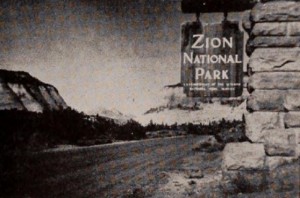
"Mr. Midgley's production is a gay and picaresque saga of a 350 mile jaunt by bicycle along the highways of Bryce and Zion National Parks and Cedar Breaks National Monument. Distinguished camera work, pleasing compositions and imaginative treatment contribute to the film's success. Outstanding in the picture, however, are its crisp pace and lighthearted laughter at the cyclist's own wry adventures. Brightly executed titles and a restrained use of a fine "running gag" round out this altogether engaging travel study." Movie Makers, Jan. 1947, 49.
"Among the films awarded honorable mention is The Grand Teton Country, carrying with it a breadth and sweep of all outdoors, a Kodacolor film by H. W. Voss, ACL. This picture is, first of all, an eloquent and colorful reply to those who do not believe that long shots can be taken successfully by this process. Time and again, in viewing this film, one is astonished by the clarity and detail of distant mountains, rearing their majestic, snow capped heads up into the cold blue of the sky, while the foreground is shown in all of its true colors. Mr. Voss has proved to skeptical Easterners that Rainbow Falls really lives up to its name. His Kodacolor camera, skillfully handled so as to produce a dark background for the rainbow formed by the sun shining on the spray, reveals perfectly that faint, tenuous beauty which is all the more remembered because evanescent. But solid, palpable colors are pictured here, too. Mountains and canyons, lakes that are mirrors, desert flowers and all the glowing colors that are part of the West, are arranged on Mr. Voss's film palette. Especially well considered was his continued use of the various neutral density filters in order to give distant shots their correct value in the brilliant sun and the inclusion of interesting action in each scene." Movie Makers, Dec. 1932, 560-561.
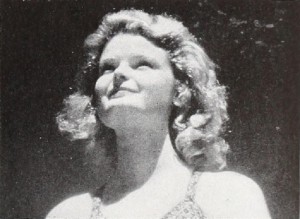
"To the production of Hail, British Columbia!, Leo J. Heffernan brought the filming talent and the fertile imagination that have marked his previous pictures. But, in this film, he has surpassed himself. He has produced a travelog, a scenic film or a record of British Columbia that covers all the diverse high lights of that province, but which still has unity. He has made a movie that is technically superior to the best theatrical travelogs, and certainly more entertaining. Mr. Heffernan has two great gifts — the capacity to improvise sequences during his travels and the ability to invent amusing and apparently natural episodes that fit the theme of his picture. This latter gift is a dual one, for it includes the ability to direct actors — people whom Mr. Heffernan meets here and there and persuades to "take a part" in his movie. The continuity of Hail, British Columbia! is ingenious and suavely followed. A girl gets off a Canadian train at a way station, where she finds a "Mountie." To him, she puts the problem, "What should I see in British Columbia?" The Mountie is somewhat taken aback, but he gradually recalls things to tell a tourist, and the picture unfolds his story. Heffernan like, there is a surprise twist at the end, which we shall not spoil by telling. Discussion of Hail, British Columbia! would be incomplete without at least a mention of the magnificent logging sequence, the clever camera work in presenting a story of a bicycle ride, the beautiful scenic shots and Canada's blondes! This picture has everything!" Movie Makers, Dec. 1941, 541.
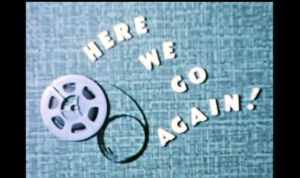
"An amateur film made by and starring the husband and wife duo, John & Evelyn Kibar. The film documents the couples’ struggles to make and complete a travelogue film of their travels to Colorado. Title cards with dialogue are dispersed throughout the film." Chicago Film Archives
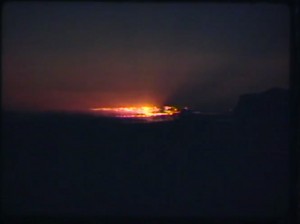
"In I Walked a Crooked Trail, O. L. Tapp has lured a good deal of motion and humor out of what must be one of the world's most static subjects — the Arches National Monument. Remembering that story interest is an important part of cinematics, Mr. Tapp has kept his very competent camera trained on continuous human action, letting his travelog unwind itself, very subtly, as a background. The film is limited by the essential triviality of its theme — the unfolding of a practical joke. But within its limits it does very well indeed." Movie Makers, Dec. 1950, 467-468.
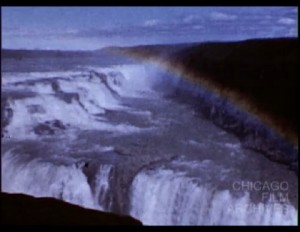
"Achieve new perspectives of Incredible Iceland as you travel with Robert Davis by plane, boat, jeep, and afoot. Exploring the many faces of this enchanting island." Lögberg-Heimskringla, Feb. 16, 1967, 8.
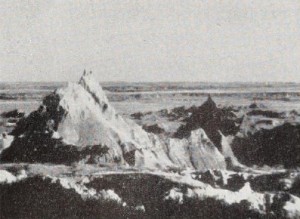
"Films about national parks and monuments fall into the traps of banality with greater ease than almost any other variety of footage. It was. therefore, with great delight that the judges reviewed Timothy and Delores Lawler's Isle of the Dead. For, using the famed Boecklin painting and the equally known Rachmaninoff music as theme and atmosphere, the Lawlers have produced a cinematic tone poem from the materials offered by Yellowstone and the Badlands. Their efforts completely dominate both music and painting, which become effective substrata of the esthetic whole. The film's great virtue and its slight defects spring from the same source — the single mood that the Lawlers have worked for and have achieved." Movie Makers, Dec. 1950, 464-465.
"'Jeep Trails Through Utah' was produced by Stan Midgley with the use of a jeep rather than his faithful bicycle. He had to leave his bicycle at home, as the deep sands of Utah can only be traveled in a jeep. In his mechanical horse he criss-crossed one of the emptiest blanks on the American map. He leaves the traveled highways and goes back into the little known areas to find fantastically beautiful and unusual natural formations. He travels over sand-blown desert trails, up rocky mountain paths and through treacherous mountain gorges to produce a gem-like picture of Utah." La Canada Valley Sun, Sept. 9, 1971.
Total Pages: 6